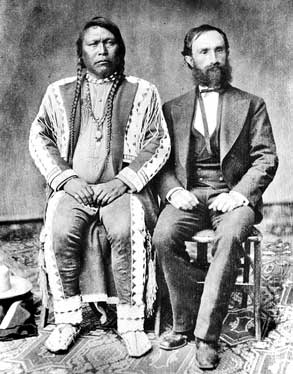By Virginia McConnell Simmons
For centuries, nomadic Ute Indians had been camping, hunting and gathering food where they chose, but their needs and how they were met changed after the Mexican-American War. The changes were far-reaching.
The States had agents appointed by the U.S. President, and New Mexico Territory also would soon have agencies to get Indian affairs organized. In this system, agents had duties such as sending reports to superintendents of Indian Affairs, overseeing distribution of annuities and goods, appointing authorized traders, and coping with a stream of supplicants – both white and Indian – since many were unhappy because land and resources were being appropriated, often with violence involved. In the 1850s, Ute Indians frequently visited an agency at Taos, where illiterate agent Kit Carson spoke English, Spanish and Indian languages and had an aide to write his reports to the superintendent, the territorial governor. Subagencies, with subagents and authorized traders, were also located at places such as Abiquiú and Cimarrón.

A few Ute Indians, like Ouray, could communicate with a Ute-Spanish-English patois, after being around places like Abiquiú, Taos, and Santa Fe. At Abiquiú, Lafayette Head, a Mexican-American War veteran from Missouri, was a trader, and, married to a Spanish-speaking lady, had become bilingual. In 1854, Head and nearby neighbors moved to Guadalupe, a new settlement in the San Luis Valley, where he continued to be a leader and soon established an adjacent plaza, Conejos.
At Conejos in 1860, Head was appointed the agent for the first Ute Indian Agency in what soon would become Colorado Territory and the seat of Conejos County. His agency and his home were in a long, low building a few yards from the plaza above the Conejos River and the local hub of activity, attracting invited or uninvited visitors – Indians, Army personnel from Fort Garland across the Valley, and idlers – sometimes with the aid of an interpreter, with mixed results.
But nothing compared to the conference when the Treaty of 1863 was negotiated. This event brought hundreds of Indians belonging to the Ute bands, troops, a large number of officials and dignitaries including the Indian superintendents/governors of the Territories of Colorado and New Mexico, and John Hay, Lincoln’s personal secretary. By that time, the Tabeguache Ute Ouray was emerging as a figure whom government officials would soon recognize as a leader, even if not all Ute Indians did.
From time to time, goods were distributed elsewhere, such as at the Salt Works in South Park and a still-standing building in Poncha Springs, while settlers, miners and farmers increased in the region. Conejos’s plaza, meanwhile, attracted Anglo merchants, employees and ranchers, and some of them, like Otto Mears, itched to expand their opportunities by creating a new town and county in the northern part of the Valley.
[InContentAdTwo]
Because of pressures in the eastern half of Colorado, the Ute Treaty of 1863 was replaced by the Treaty of 1868 (“Kit Carson Treaty”), giving Ute Indians in Colorado a reservation on the land west of the Continental Divide, with the boundary being the 107th Parallel, not the Divide itself. To Head’s dismay, his agency closed, while the ever-busy Mears and his cronies promoted the creation of an agency northwest of Saguache to boost the locale’s agricultural and commercial interests.
This agency was too far from areas habituated by other Ute bands, so the new Los Pinos Agency on Los Pinos Creek served mainly the Tabeguache Band. It could be lively and attracted large encampments during the distribution of rations and livestock that resembled a free-for-all. With the advent of the San Juan Mining boom, a stage line to Lake City ran past the agency, and wayfarers like the notorious cannibal Alferd (Alfred) Packer wandered in. The agent was Charles Adams, brother-in-law of Territorial Governor McCook, and Adams’ wife was on the payroll too, as a teacher.
In 1874, the agency moved to Los Pinos Agency No. 2 in the Uncompahgre Valley, with Henry Bond as agent, Mrs. Bond as teacher, and Chief Ouray and Chipeta as neighbors. Agencies also existed for Colorado’s other bands. The Southern Ute Agency was established in 1873 at Ignacio, and bands in northwestern Colorado had agencies in Middle Park and White River. The latter agency, near Meeker, was the site of the massacre in 1879 that led to eviction of northern bands of Utes from Colorado, and of the Tabeguaches, too, for no justifiable reason. Since the 1880s, Ute Indians in Colorado have had just two agencies, at Ignacio and Towaoc, serving Southern Ute and Ute Mountain Ute Indians.
Simmons is the author of The Ute Indians of Utah, Colorado and New Mexico.


